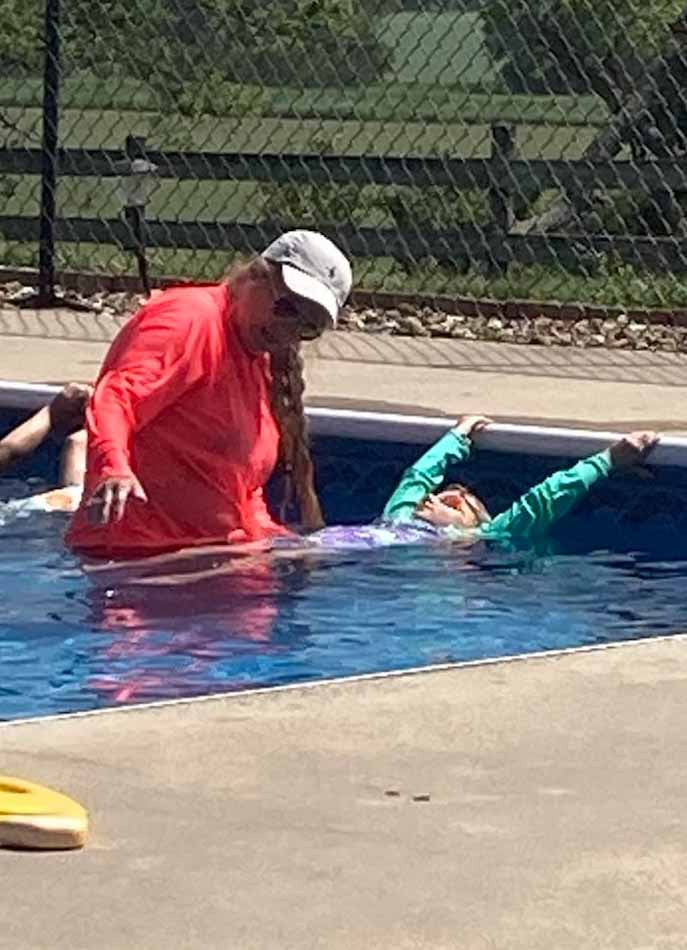|
Glancing up from your phone, you turn your attention to the water and do a quick search for your kiddos in the pool. Your heart starts beating a little faster as you realize you cannot find one. The lifeguard sits perched unassuming high in their chair. Your search goes from the 4 foot section to the 5 foot section, to the deep end. Then, across the way, you see someone waving at you from the concession stand line. It is the familiar face of your too eager to be independent child. Clutching your chest, you rush over, realizing the scenario could have ended so tragically. It’s time to tuck the phone away and be attentive, you remind yourself. Pool and water related accidents happen quickly. We can equip the children in our lives to enjoy the water safely. These rules empower young swimmers, and as a bonus, serve as helpful reminders to us adults. Don’t swim without a grown-up It sounds so simple, doesn’t it? Drill it in, even a toddler should be able to recite this one. Apply it to wading pools and bathtubs too. Adults are not invincible, we need to remember to swim with a buddy or onlooker. You never know when a leg cramp or a dizzy spell can set in. No running Showing up to the pool or lake is exciting, it is hard to contain all the excitement, but swim surfaces can be slippery and docks can pose a tripping hazard. Walking can limit accidental falls (or shoves) into the water, cuts and scrapes. Falls can also increase the likelihood of head injuries, which can incapacitate a swimmer. Don’t touch the mechanicals in the pool The filter system and pool drain are not for children and should be avoided. Loose clothing or ponytails can be sucked in, creating a huge safety issue. Wear a bright swimming suit Choose swimwear that stands out from the pool liner. Pink, yellow, orange, red, and lime green are great choices. A swimmer struggling under the water can be spotted easier if they’re wearing something bright, especially if the pool is full of activity. Know water depth before jumping in Teach children to look for or ask about the water depth before getting in the water. Shallow water should be waded into; no jumping or diving. A minimum of 9 feet of water is recommended for diving. No chewing gum or food Something as simple as chewing gum or a quick bite of food can throw off a swimmer's ability to hold their breath and blow bubbles from their nose, causing an accidental intake of water or choking. Encourage children to spit out gum and finish snacks before getting into the water. Kids don’t rescue struggling swimmers While we all want to raise little heroes, the water is not the proper setting. Children can easily be pulled under the water by a panicked swimmer. Teach children to throw a floaty to a swimmer in need and then find a grown-up to help. Yearly swimming lessons will reinforce these rules and improve skill and technique; plus kiddos are often eager to learn. Children too young for swimming lessons should wear an appropriate fitting life jacket while in and around the water. Even children who are able to swim well in a pool, should consider wearing a life jacket in lakes where visibility is reduced. These water safety rules will empower your children to have fun in the water and maintain healthy boundaries for their developmental level. Consider them tools in your family’s summer safety tool kit. Here’s to a safe and fun July 4th weekend! Sara Lynn, RN, BSN “If you don’t invest in your health, no one else will.” Collaboration on this blog, courtesy of Charlotte Sears, local swim instructor.
0 Comments
Your comment will be posted after it is approved.
Leave a Reply. |
Blog Info
Archives
June 2024
Categories
All
|
|
Visit our Locations
IFM | West Des Moines 475 S. 50th St., Suite 600 West Des Moines, IA, 50265 *Temporarily Closed* IFM | Ankeny 207 NE Delaware Ave. Suite 20 Ankeny, IA 50021 |
Office HoursMonday 9:00 a.m. - 5:00 p.m. Tuesday 9:00 a.m. - 5:00 p.m. Wednesday 9:00 a.m. - 5:00 p.m. Thursday 9:00 a.m. - 5:00 p.m. Friday by appointment. Sat & Sun Closed |
© 2024 Integrative Family Medicine of Iowa, PLLC.
All rights reserved.
All rights reserved.







 RSS Feed
RSS Feed

